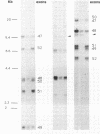Abstract
It has been hypothesized that the tight localization of dystrophin at the muscle membrane is carried out by its cysteine-rich and/or carboxyl domains. We report the results of biochemical and immunocytochemical investigations of dystrophin in muscle from a 1-yr-old patient with a large deletion that removes the distal part of the dystrophin gene, thus spanning the exons coding for the cysteine-rich and the carboxy-terminal domains, and extends beyond the glycerol kinase and congenital adrenal hypoplasia genes. Immunological analysis of muscle dystrophin shows that the deletion results in the production of a truncated, but stable, polypeptide correctly localized at the sarcolemma. These data indicate that neither the cysteine-rich domain, nor the carboxyl domain, are necessary for the appearance of normal dystrophin sarcolemmal localization.
Full text
PDF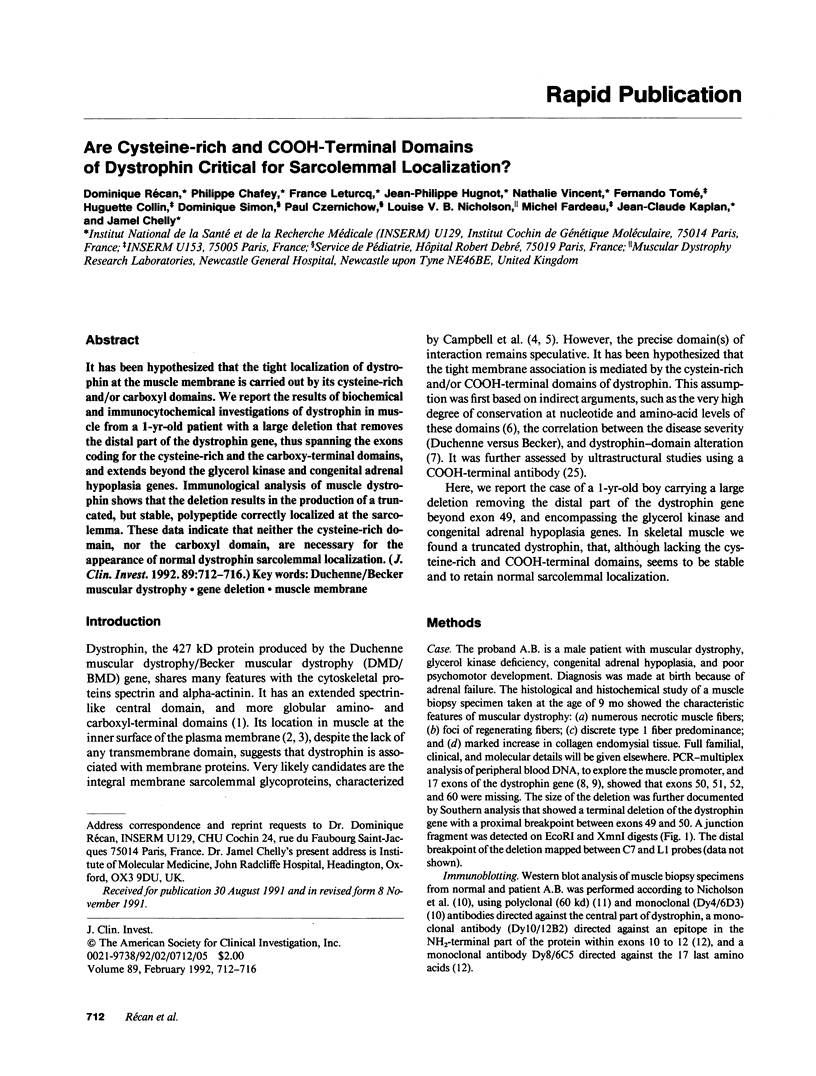
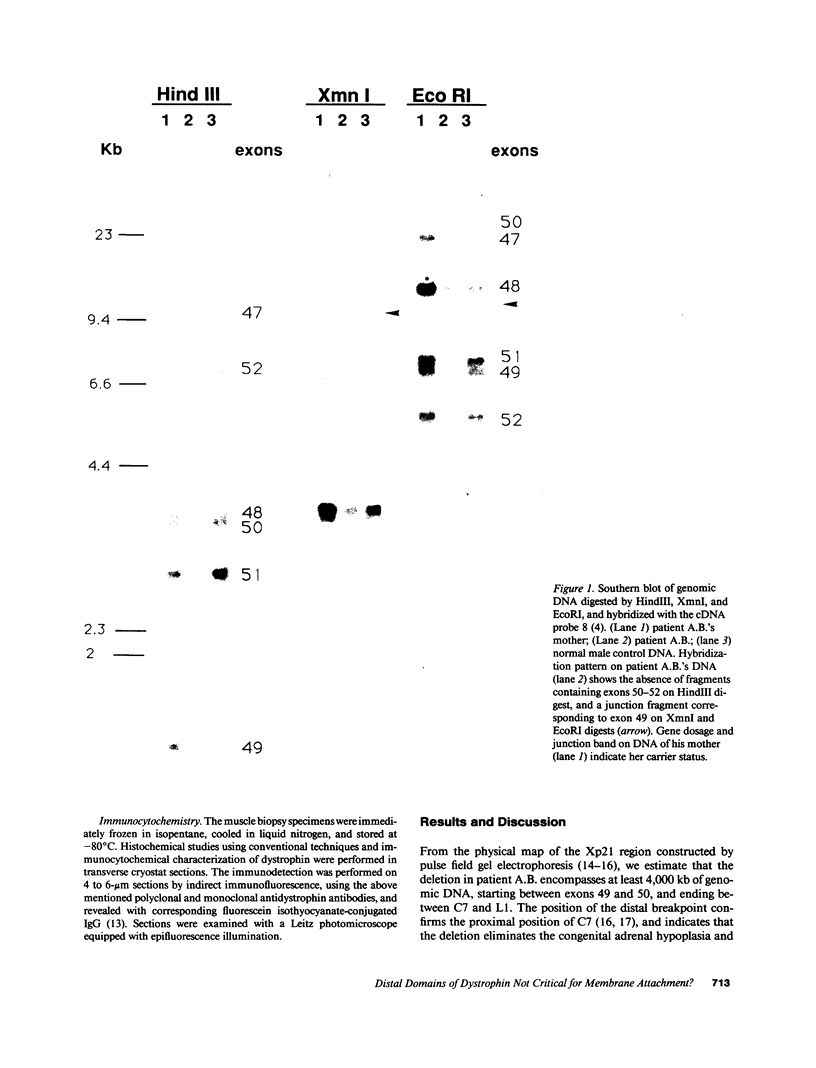
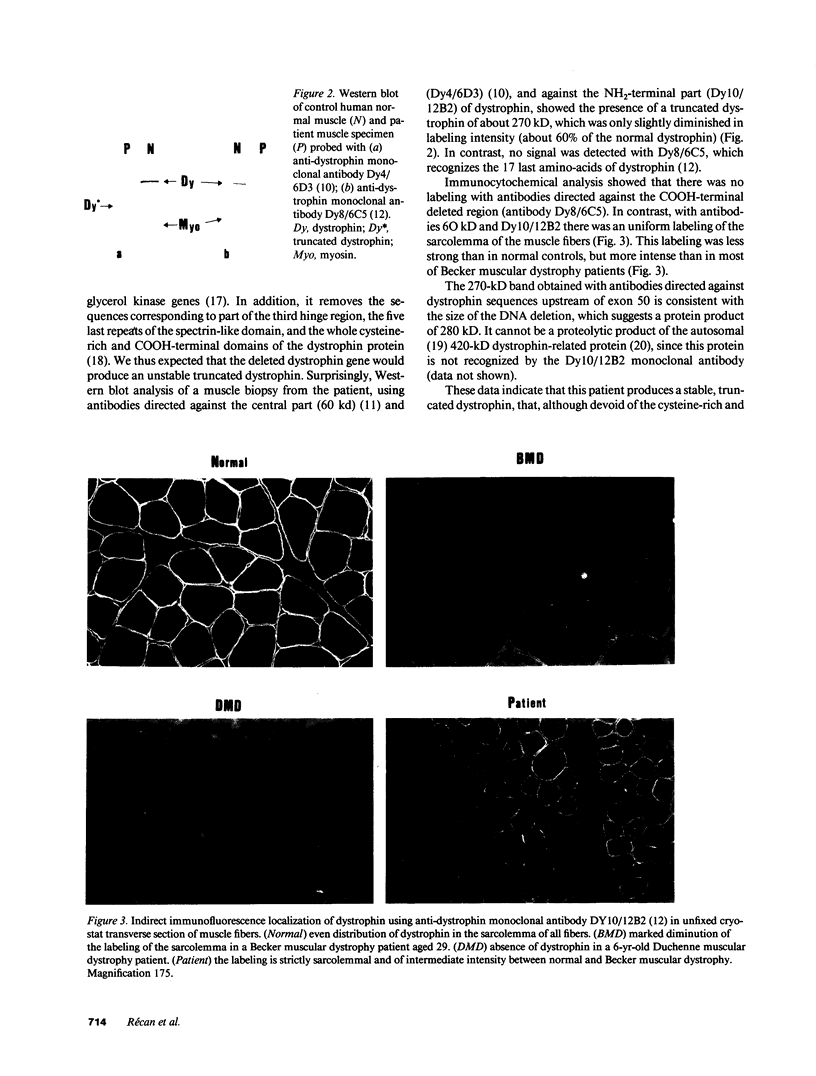
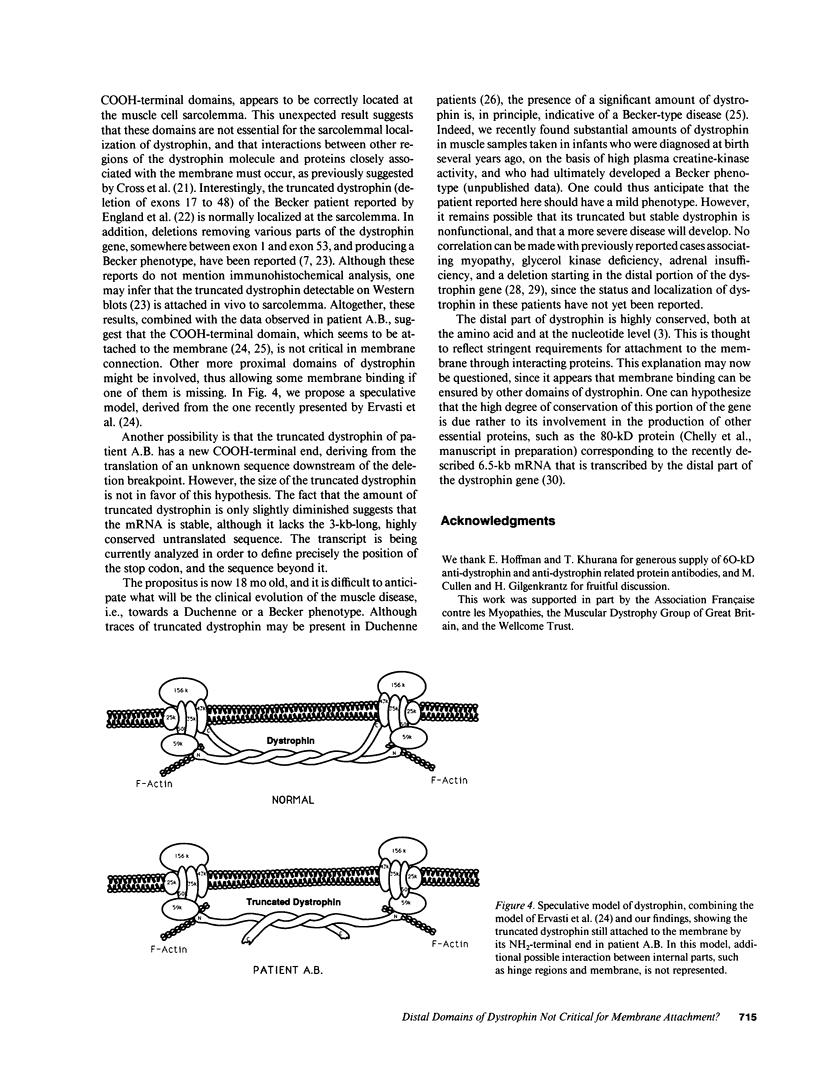
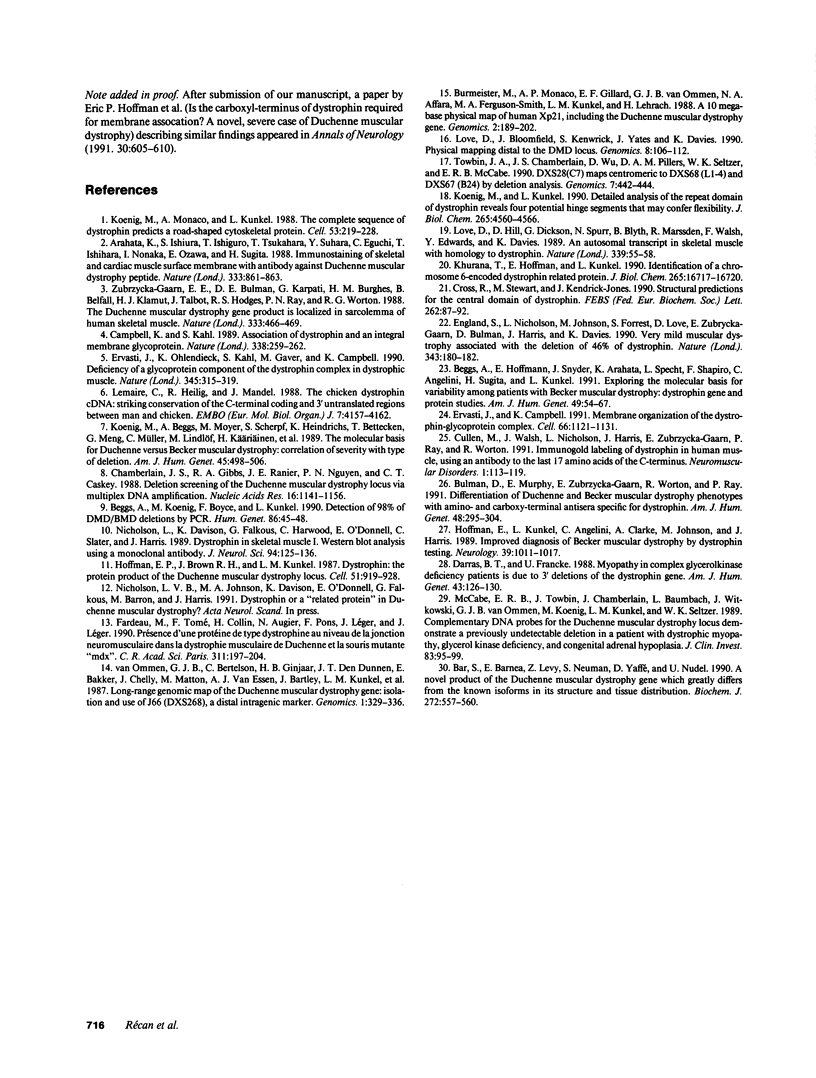
Images in this article
Selected References
These references are in PubMed. This may not be the complete list of references from this article.
- Arahata K., Ishiura S., Ishiguro T., Tsukahara T., Suhara Y., Eguchi C., Ishihara T., Nonaka I., Ozawa E., Sugita H. Immunostaining of skeletal and cardiac muscle surface membrane with antibody against Duchenne muscular dystrophy peptide. Nature. 1988 Jun 30;333(6176):861–863. doi: 10.1038/333861a0. [DOI] [PubMed] [Google Scholar]
- Bar S., Barnea E., Levy Z., Neuman S., Yaffe D., Nudel U. A novel product of the Duchenne muscular dystrophy gene which greatly differs from the known isoforms in its structure and tissue distribution. Biochem J. 1990 Dec 1;272(2):557–560. doi: 10.1042/bj2720557. [DOI] [PMC free article] [PubMed] [Google Scholar]
- Beggs A. H., Hoffman E. P., Snyder J. R., Arahata K., Specht L., Shapiro F., Angelini C., Sugita H., Kunkel L. M. Exploring the molecular basis for variability among patients with Becker muscular dystrophy: dystrophin gene and protein studies. Am J Hum Genet. 1991 Jul;49(1):54–67. [PMC free article] [PubMed] [Google Scholar]
- Beggs A. H., Koenig M., Boyce F. M., Kunkel L. M. Detection of 98% of DMD/BMD gene deletions by polymerase chain reaction. Hum Genet. 1990 Nov;86(1):45–48. doi: 10.1007/BF00205170. [DOI] [PubMed] [Google Scholar]
- Bulman D. E., Murphy E. G., Zubrzycka-Gaarn E. E., Worton R. G., Ray P. N. Differentiation of Duchenne and Becker muscular dystrophy phenotypes with amino- and carboxy-terminal antisera specific for dystrophin. Am J Hum Genet. 1991 Feb;48(2):295–304. [PMC free article] [PubMed] [Google Scholar]
- Burmeister M., Monaco A. P., Gillard E. F., van Ommen G. J., Affara N. A., Ferguson-Smith M. A., Kunkel L. M., Lehrach H. A 10-megabase physical map of human Xp21, including the Duchenne muscular dystrophy gene. Genomics. 1988 Apr;2(3):189–202. doi: 10.1016/0888-7543(88)90002-x. [DOI] [PubMed] [Google Scholar]
- Campbell K. P., Kahl S. D. Association of dystrophin and an integral membrane glycoprotein. Nature. 1989 Mar 16;338(6212):259–262. doi: 10.1038/338259a0. [DOI] [PubMed] [Google Scholar]
- Cross R. A., Stewart M., Kendrick-Jones J. Structural predictions for the central domain of dystrophin. FEBS Lett. 1990 Mar 12;262(1):87–92. doi: 10.1016/0014-5793(90)80160-k. [DOI] [PubMed] [Google Scholar]
- Cullen M. J., Walsh J., Nicholson L. V., Harris J. B., Zubrzycka-Gaarn E. E., Ray P. N., Worton R. G. Immunogold labelling of dystrophin in human muscle, using an antibody to the last 17 amino acids of the C-terminus. Neuromuscul Disord. 1991;1(2):113–119. doi: 10.1016/0960-8966(91)90058-z. [DOI] [PubMed] [Google Scholar]
- Darras B. T., Francke U. Myopathy in complex glycerol kinase deficiency patients is due to 3' deletions of the dystrophin gene. Am J Hum Genet. 1988 Aug;43(2):126–130. [PMC free article] [PubMed] [Google Scholar]
- England S. B., Nicholson L. V., Johnson M. A., Forrest S. M., Love D. R., Zubrzycka-Gaarn E. E., Bulman D. E., Harris J. B., Davies K. E. Very mild muscular dystrophy associated with the deletion of 46% of dystrophin. Nature. 1990 Jan 11;343(6254):180–182. doi: 10.1038/343180a0. [DOI] [PubMed] [Google Scholar]
- Ervasti J. M., Campbell K. P. Membrane organization of the dystrophin-glycoprotein complex. Cell. 1991 Sep 20;66(6):1121–1131. doi: 10.1016/0092-8674(91)90035-w. [DOI] [PubMed] [Google Scholar]
- Ervasti J. M., Ohlendieck K., Kahl S. D., Gaver M. G., Campbell K. P. Deficiency of a glycoprotein component of the dystrophin complex in dystrophic muscle. Nature. 1990 May 24;345(6273):315–319. doi: 10.1038/345315a0. [DOI] [PubMed] [Google Scholar]
- Fardeau M., Tomé F. M., Collin H., Augier N., Pons F., Léger J., Léger J. Présence d'une protéine de type dystrophine au niveau de la jonction neuromusculaire dans la dystrophie musculaire de Duchenne et la souris mutante "mdx". C R Acad Sci III. 1990;311(5):197–204. [PubMed] [Google Scholar]
- Hoffman E. P., Brown R. H., Jr, Kunkel L. M. Dystrophin: the protein product of the Duchenne muscular dystrophy locus. Cell. 1987 Dec 24;51(6):919–928. doi: 10.1016/0092-8674(87)90579-4. [DOI] [PubMed] [Google Scholar]
- Hoffman E. P., Garcia C. A., Chamberlain J. S., Angelini C., Lupski J. R., Fenwick R. Is the carboxyl-terminus of dystrophin required for membrane association? A novel, severe case of Duchenne muscular dystrophy. Ann Neurol. 1991 Oct;30(4):605–610. doi: 10.1002/ana.410300414. [DOI] [PubMed] [Google Scholar]
- Hoffman E. P., Kunkel L. M., Angelini C., Clarke A., Johnson M., Harris J. B. Improved diagnosis of Becker muscular dystrophy by dystrophin testing. Neurology. 1989 Aug;39(8):1011–1017. doi: 10.1212/wnl.39.8.1011. [DOI] [PubMed] [Google Scholar]
- Khurana T. S., Hoffman E. P., Kunkel L. M. Identification of a chromosome 6-encoded dystrophin-related protein. J Biol Chem. 1990 Oct 5;265(28):16717–16720. [PubMed] [Google Scholar]
- Koenig M., Beggs A. H., Moyer M., Scherpf S., Heindrich K., Bettecken T., Meng G., Müller C. R., Lindlöf M., Kaariainen H. The molecular basis for Duchenne versus Becker muscular dystrophy: correlation of severity with type of deletion. Am J Hum Genet. 1989 Oct;45(4):498–506. [PMC free article] [PubMed] [Google Scholar]
- Koenig M., Kunkel L. M. Detailed analysis of the repeat domain of dystrophin reveals four potential hinge segments that may confer flexibility. J Biol Chem. 1990 Mar 15;265(8):4560–4566. [PubMed] [Google Scholar]
- Koenig M., Monaco A. P., Kunkel L. M. The complete sequence of dystrophin predicts a rod-shaped cytoskeletal protein. Cell. 1988 Apr 22;53(2):219–228. doi: 10.1016/0092-8674(88)90383-2. [DOI] [PubMed] [Google Scholar]
- Lemaire C., Heilig R., Mandel J. L. The chicken dystrophin cDNA: striking conservation of the C-terminal coding and 3' untranslated regions between man and chicken. EMBO J. 1988 Dec 20;7(13):4157–4162. doi: 10.1002/j.1460-2075.1988.tb03311.x. [DOI] [PMC free article] [PubMed] [Google Scholar]
- Love D. R., Bloomfield J. F., Kenwrick S. J., Yates J. R., Davies K. E. Physical mapping distal to the DMD locus. Genomics. 1990 Sep;8(1):106–112. doi: 10.1016/0888-7543(90)90231-i. [DOI] [PubMed] [Google Scholar]
- Love D. R., Hill D. F., Dickson G., Spurr N. K., Byth B. C., Marsden R. F., Walsh F. S., Edwards Y. H., Davies K. E. An autosomal transcript in skeletal muscle with homology to dystrophin. Nature. 1989 May 4;339(6219):55–58. doi: 10.1038/339055a0. [DOI] [PubMed] [Google Scholar]
- McCabe E. R., Towbin J., Chamberlain J., Baumbach L., Witkowski J., van Ommen G. J., Koenig M., Kunkel L. M., Seltzer W. K. Complementary DNA probes for the Duchenne muscular dystrophy locus demonstrate a previously undetectable deletion in a patient with dystrophic myopathy, glycerol kinase deficiency, and congenital adrenal hypoplasia. J Clin Invest. 1989 Jan;83(1):95–99. doi: 10.1172/JCI113890. [DOI] [PMC free article] [PubMed] [Google Scholar]
- Nicholson L. V., Davison K., Falkous G., Harwood C., O'Donnell E., Slater C. R., Harris J. B. Dystrophin in skeletal muscle. I. Western blot analysis using a monoclonal antibody. J Neurol Sci. 1989 Dec;94(1-3):125–136. doi: 10.1016/0022-510x(89)90223-2. [DOI] [PubMed] [Google Scholar]
- Towbin J. A., Chamberlain J. S., Wu D. R., Pillers D. A., Seltzer W. K., McCabe E. R. DXS28 (C7) maps centromeric to DXS68 (L1-4) and DXS67 (B24) by deletion analysis. Genomics. 1990 Jul;7(3):442–444. doi: 10.1016/0888-7543(90)90181-s. [DOI] [PubMed] [Google Scholar]
- Zubrzycka-Gaarn E. E., Bulman D. E., Karpati G., Burghes A. H., Belfall B., Klamut H. J., Talbot J., Hodges R. S., Ray P. N., Worton R. G. The Duchenne muscular dystrophy gene product is localized in sarcolemma of human skeletal muscle. Nature. 1988 Jun 2;333(6172):466–469. doi: 10.1038/333466a0. [DOI] [PubMed] [Google Scholar]
- van Ommen G. J., Bertelson C., Ginjaar H. B., den Dunnen J. T., Bakker E., Chelly J., Matton M., van Essen A. J., Bartley J., Kunkel L. M. Long-range genomic map of the Duchenne muscular dystrophy (DMD) gene: isolation and use of J66 (DXS268), a distal intragenic marker. Genomics. 1987 Dec;1(4):329–336. doi: 10.1016/0888-7543(87)90032-2. [DOI] [PubMed] [Google Scholar]



